By "proportions" I assume he means calculating the proportions of water amounts in the industrial brewing records and then scaling them down to 6.5 gallons.
You are using an out of date browser. It may not display this or other websites correctly.
You should upgrade or use an alternative browser.
You should upgrade or use an alternative browser.
Homebrewer's Guide to Vintage Beer
- Thread starter patto1ro
- Start date

Help Support Homebrew Talk:
This site may earn a commission from merchant affiliate
links, including eBay, Amazon, and others.
McKnuckle
Well-Known Member
I really appreciate the legwork taken to get that answer. Thanks! I assumed that the 6.5 gallons was too low, and also that it had been scaled from original records to obtain a total water volume for each recipe. Ron probably should have scaled to a higher amount allowing for absorption/evap as he says. But as long as it's explained, I'm good.
Well, I'm going to brew the 1804 Barclay Perkins TT (first recipe in the book). I've got it set up in Brewer's Friend for 3 gallons, so we'll see what happens...
Well, I'm going to brew the 1804 Barclay Perkins TT (first recipe in the book). I've got it set up in Brewer's Friend for 3 gallons, so we'll see what happens...

It occured to me just now that it's probably Ron that started this thread (patto1ro) but maybe he doesn't actually hang about the forums at all...
McKnuckle
Well-Known Member
Yes I see that too. I think once I finally brew one of the recipes, the sense of mystery will evaporate. Also, I'll relax and remember that it's always going to be an approximation of a historical recipe, no matter how much we try to follow things to the letter.
I really appreciate the legwork taken to get that answer. Thanks! I assumed that the 6.5 gallons was too low, and also that it had been scaled from original records to obtain a total water volume for each recipe. Ron probably should have scaled to a higher amount allowing for absorption/evap as he says. But as long as it's explained, I'm good.
Well, I'm going to brew the 1804 Barclay Perkins TT (first recipe in the book). I've got it set up in Brewer's Friend for 3 gallons, so we'll see what happens...
I never use the quantities in any homebrew recipe as my batch size and efficiency never matches what they give. I just use the grist percentages. My one complaint would be that the hops aren't given as weight per volume (as was done in Mitch Steel's IPA) but it doesn't really matter with historic recipes as they are just an educated guess.
McKnuckle
Well-Known Member
I brewed a small batch of the 1804 Barclay Perkins TT today, and kept the grist accurate to the percentages in the book. I used Fawcett Pearl for the pale malt, and Crisp products for brown and amber. I must say, the brown malt is a unique grain and my eyebrows were raised as soon as I smelled/tasted it. It's very dry and astringent, with almost no perceptible sweetness. My expectations were immediately reset a bit... that stuff is 46% of the bill!
I managed to hit the OG of 1.055 and I used whole leaf EK Goldings hops in three additions, 90, 45, and 15. This differs a bit from the recipe, but it's acknowledged that the hop schedules are mostly educated guesses anyway.
Tasting the hydrometer sample, the wort is quite bitter, but oddly pleasant in spite of itself. It's like drinking toasted pumpernickel bread with the crust slightly burnt. I'll follow up with a tap report in a few weeks, sooner if anything interesting happens.
(The hydrometer is lit by ambient light, so the beer appears orange. It's really the dark brown color visible in the carboy.)
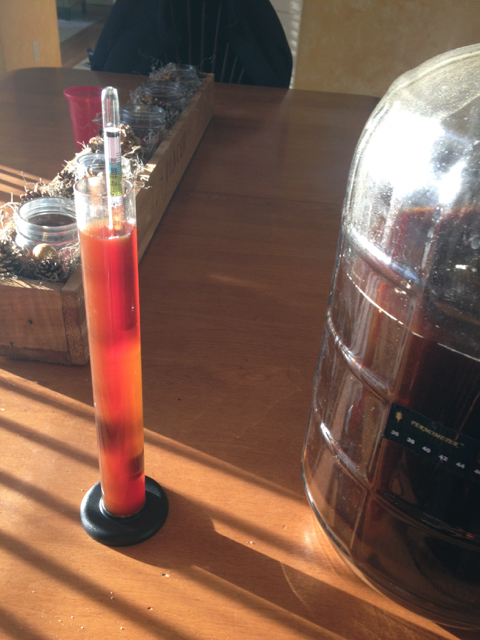
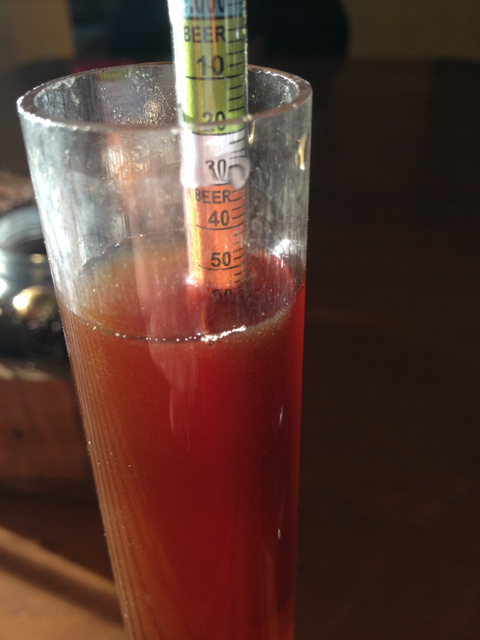
I managed to hit the OG of 1.055 and I used whole leaf EK Goldings hops in three additions, 90, 45, and 15. This differs a bit from the recipe, but it's acknowledged that the hop schedules are mostly educated guesses anyway.
Tasting the hydrometer sample, the wort is quite bitter, but oddly pleasant in spite of itself. It's like drinking toasted pumpernickel bread with the crust slightly burnt. I'll follow up with a tap report in a few weeks, sooner if anything interesting happens.
(The hydrometer is lit by ambient light, so the beer appears orange. It's really the dark brown color visible in the carboy.)



$10.99 ($31.16 / Ounce)
Hornindal Kveik Yeast for Homebrewing - Mead, Cider, Wine, Beer - 10g Packet - Saccharomyces Cerevisiae - Sold by Shadowhive.com
Shadowhive

$53.24
1pc Hose Barb/MFL 1.5" Tri Clamp to Ball Lock Post Liquid Gas Homebrew Kegging Fermentation Parts Brewer Hardware SUS304(Liquid Hose Barb)
Guangshui Weilu You Trading Co., Ltd

$58.16
HUIZHUGS Brewing Equipment Keg Ball Lock Faucet 30cm Reinforced Silicone Hose Secondary Fermentation Homebrew Kegging Brewing Equipment
xiangshuizhenzhanglingfengshop

$159.50 ($26.58 / Count)
3M High Flow Series System BREW120-MS, 5616001, For Brewed Coffee and Hot Tea, Valve-in-Head Design
Amazon.com

$176.97
1pc Commercial Keg Manifold 2" Tri Clamp,Ball Lock Tapping Head,Pressure Gauge/Adjustable PRV for Kegging,Fermentation Control
hanhanbaihuoxiaoshoudian

$44.99
$49.95
Craft A Brew - Mead Making Kit – Reusable Make Your Own Mead Kit – Yields 1 Gallon of Mead
Craft a Brew

$7.79 ($7.79 / Count)
Craft A Brew - LalBrew Voss™ - Kveik Ale Yeast - For Craft Lagers - Ingredients for Home Brewing - Beer Making Supplies - (1 Pack)
Craft a Brew

$53.24
1pc Hose Barb/MFL 1.5" Tri Clamp to Ball Lock Post Liquid Gas Homebrew Kegging Fermentation Parts Brewer Hardware SUS304(Liquid Hose Barb)
yunchengshiyanhuqucuichendianzishangwuyouxiangongsi

$33.99 ($17.00 / Count)
$41.99 ($21.00 / Count)
2 Pack 1 Gallon Large Fermentation Jars with 3 Airlocks and 2 SCREW Lids(100% Airtight Heavy Duty Lid w Silicone) - Wide Mouth Glass Jars w Scale Mark - Pickle Jars for Sauerkraut, Sourdough Starter
Qianfenie Direct
![Craft A Brew - Safale S-04 Dry Yeast - Fermentis - English Ale Dry Yeast - For English and American Ales and Hard Apple Ciders - Ingredients for Home Brewing - Beer Making Supplies - [1 Pack]](https://m.media-amazon.com/images/I/41fVGNh6JfL._SL500_.jpg)
$6.95 ($17.38 / Ounce)
$7.47 ($18.68 / Ounce)
Craft A Brew - Safale S-04 Dry Yeast - Fermentis - English Ale Dry Yeast - For English and American Ales and Hard Apple Ciders - Ingredients for Home Brewing - Beer Making Supplies - [1 Pack]
Hobby Homebrew

$22.00 ($623.23 / Ounce)
AMZLMPKNTW Ball Lock Sample Faucet 30cm Reinforced Silicone Hose Secondary Fermentation Homebrew Kegging joyful
无为中南商贸有限公司

$172.35
2 Inch Tri Clamp Keg Manifold With Ball Lock Posts, Pressure Gauge, PRV (0-30 PSI) – Homebrew, Fermentation, Kegging System
wuhanshijiayangzhiyimaoyiyouxiangongsi

$719.00
$799.00
EdgeStar KC2000TWIN Full Size Dual Tap Kegerator & Draft Beer Dispenser - Black
Amazon.com

$49.95 ($0.08 / Fl Oz)
$52.99 ($0.08 / Fl Oz)
Brewer's Best - 1073 - Home Brew Beer Ingredient Kit (5 gallon), (Blueberry Honey Ale) Golden
Amazon.com

$20.94
$29.99
The Brew Your Own Big Book of Clone Recipes: Featuring 300 Homebrew Recipes from Your Favorite Breweries
Amazon.com
I brewed a small batch of the 1804 Barclay Perkins TT today, and kept the grist accurate to the percentages in the book. I used Fawcett Pearl for the pale malt, and Crisp products for brown and amber. I must say, the brown malt is a unique grain and my eyebrows were raised as soon as I smelled/tasted it. It's very dry and astringent, with almost no perceptible sweetness. My expectations were immediately reset a bit... that stuff is 46% of the bill!)
I actually just brewed this last Sunday, though adjusted for a 60 min boil and subbing Victory for Amber. I'm interested to hear how yours turns out, as mine was my first AG/BIAB attempt, and I ended up mashing a bit higher than I would've liked. Certainly smells/tastes different to what I was expecting.
McKnuckle
Well-Known Member
That's great and I'm most interested to compare notes. What did you use for pale and brown malts? I mashed in at 151 and left my cooler/tun alone for about 75 minutes, and when I returned the mash was at 146. Odd because normally, it loses no more than a degree in an hour. I'm hoping it stayed reasonably close to target for most of the mash. I got lower efficiency than usual, but boiled hard and hit my OG anyway.
The main thing is the taste of this sucker... Dark toasty bread all the way, maybe a hint of Goldings too. Perhaps this is what you actually got at the pub at the turn of the 19th century!
The main thing is the taste of this sucker... Dark toasty bread all the way, maybe a hint of Goldings too. Perhaps this is what you actually got at the pub at the turn of the 19th century!
McKnuckle
Well-Known Member
The 1804 TT is five days into primary and slowing way down; it's already quite clear although I'm holding off on a gravity reading for a couple more days. It tastes and smells as close to coffee as I can imagine anything other than real coffee actually tasting and smelling! It's got an interesting tangy backbone as well. I hope these qualities continue to hold up as it finishes and matures, because it's quite good. It's way more spicy and interesting than it was right after the boil.
kelvarnsen
Member
- Joined
- Jan 19, 2015
- Messages
- 5
- Reaction score
- 1
My wife got me this book for Valentine's day. I am excited to try it. I am curious to see how these recipes with 100+ IBU's turn out. Anyone else try any of the recipes in it?
Also anyone have any luck, or have a good process for making (or better yet buying) and using brewers caramel? Does it add any flavour or just colour?
Also anyone have any luck, or have a good process for making (or better yet buying) and using brewers caramel? Does it add any flavour or just colour?
My wife got me this book for Valentine's day. I am excited to try it. I am curious to see how these recipes with 100+ IBU's turn out. Anyone else try any of the recipes in it?
Also anyone have any luck, or have a good process for making (or better yet buying) and using brewers caramel? Does it add any flavour or just colour?
I don't think anyone sells it, here is how to make it http://www.unholymess.com/blog/beer-brewing-info/making-brewers-caramel
I did this once but often omit the caramel or use a debittered black malt like carafa special or midnight wheat to hit the SRMs if the beer really NEEDS to be darker (ie. nobody outside of the BJCP wants a porter to be brown)
...and while there, here is a good method for making the darker inverts http://www.unholymess.com/blog/beer-brewing-info/making-brewers-invert
...and if you get through all of the recipes in the book, here is a list of all of recipes Ron posted on his blog: http://www.unholymess.com/blog/lets-brew
They are worth reading for the discussion and brewing notes from Kristen England.
McKnuckle
Well-Known Member
That's a great compilation website - thank you!
My 1804 B.P. TT is bottle conditioning now. Couple more weeks til I crack one open...
My 1804 B.P. TT is bottle conditioning now. Couple more weeks til I crack one open...
McKnuckle
Well-Known Member
Finally time for a tap...er, bottle report. Fourteen days conditioning and carbonation is perfect with a long lasting head. This is good beer! Very roasty with a seriously authentic and unique coffee aroma/flavor. There is NO coffee in this beer, I swear! Just 46% brown malt, which is certainly an uncommon ingredient, especially in such high proportion.
Beer finished at a fairly high FG of 1.021, leaving it nice and malty with a low-ish ABV under 5%. Even so, the bitterness is balanced with the rich flavors. I will be enjoying this one. Good luck with your vintage recipes, all... I'll be looking into brewing another one soon.
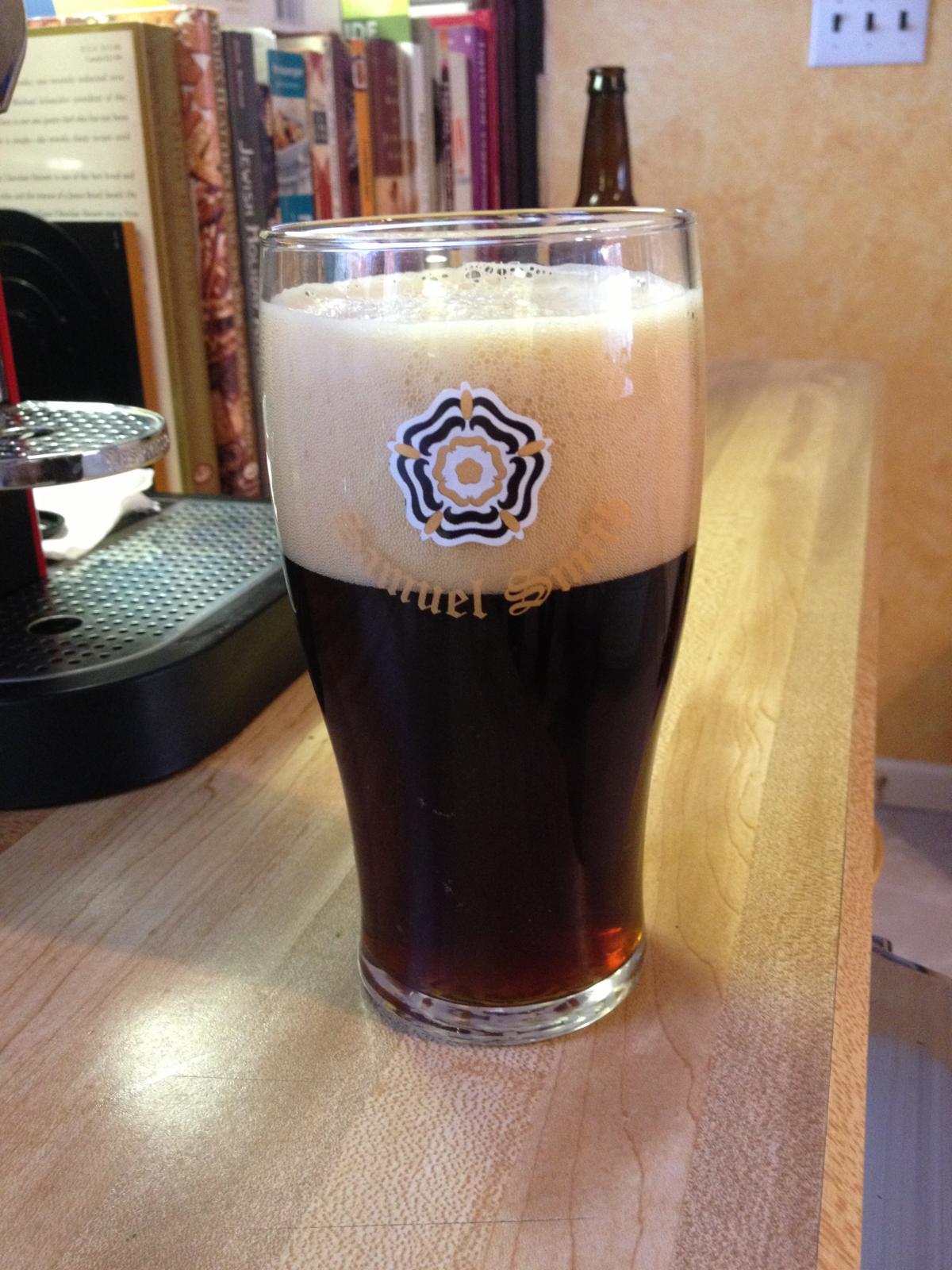
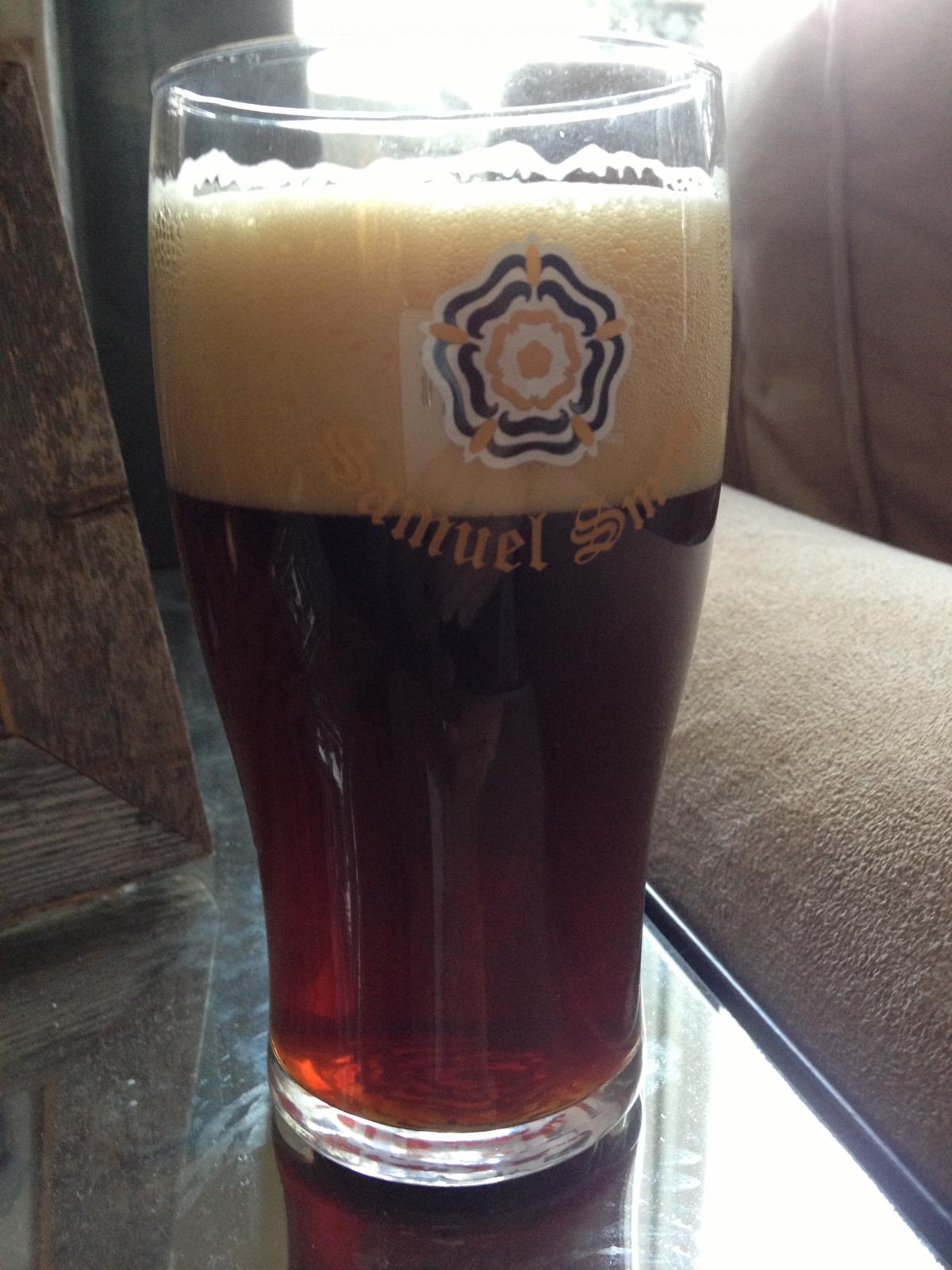
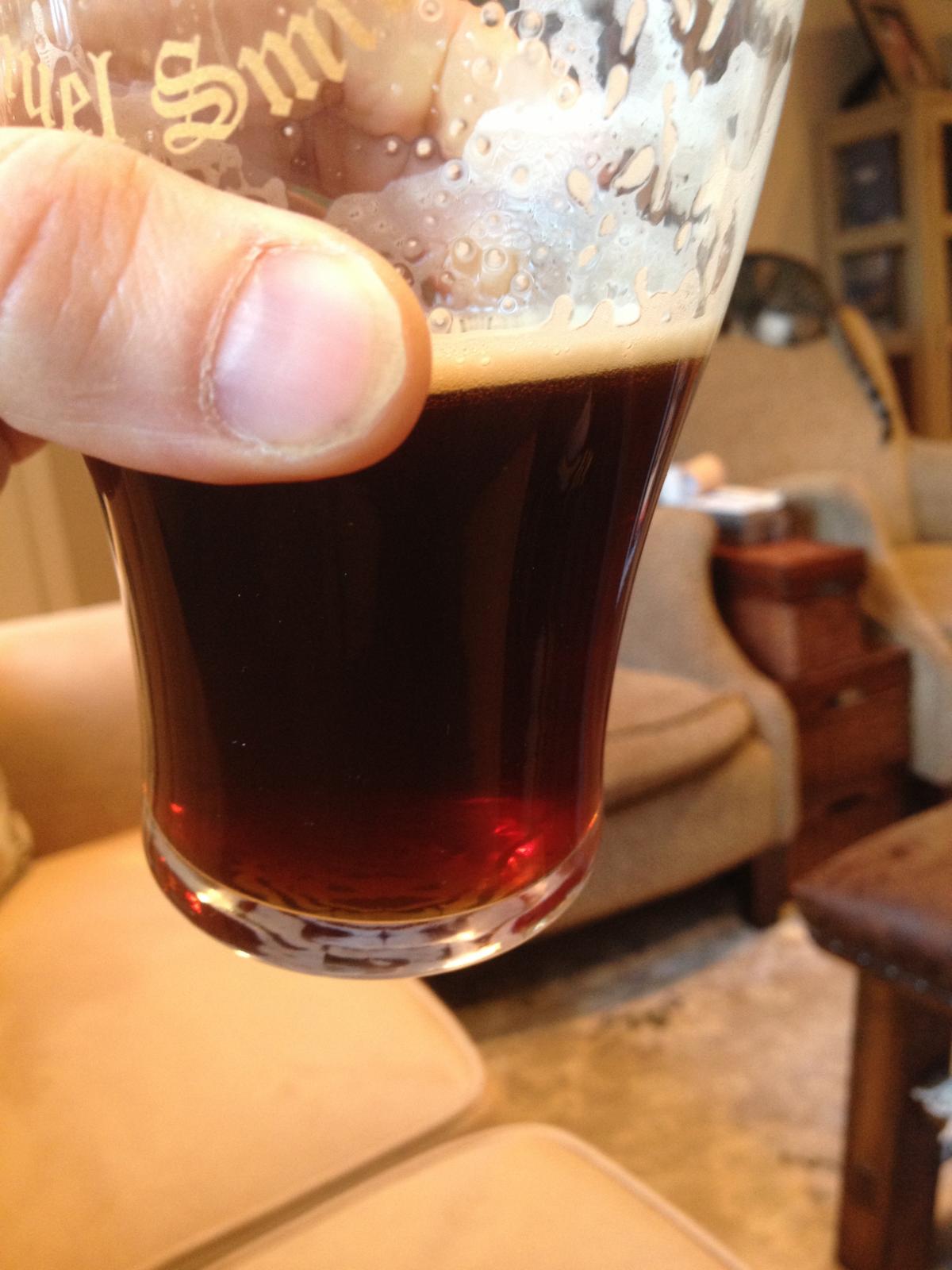
Beer finished at a fairly high FG of 1.021, leaving it nice and malty with a low-ish ABV under 5%. Even so, the bitterness is balanced with the rich flavors. I will be enjoying this one. Good luck with your vintage recipes, all... I'll be looking into brewing another one soon.



kelvarnsen
Member
- Joined
- Jan 19, 2015
- Messages
- 5
- Reaction score
- 1
So I ended up making the Reid 1839 IPA. It was crazy. I made like a 2.5 gallon batch and used 4 ounces of hops. When I made the 30 minute addition, and the hop pellets broke up I thought for awhile that I might end up with green beer, since there was so much hop material in the kettle. When I transfer the fermentor I just dump though a funnel with a wire mesh screen on it. I think I must have had to clear out the screen 2 or 3 times if not more. When I bottle I usually get at least 23 bottles, but I think this time I only got 20, and I have to think at least part of that is because of all the wort the hops absorbed.
All in all though it is a good beer. Surprising at how drinkable it is at 177 IBU with no late addition hops. Plus you still get some actual hop flavour (not just bitterness which surprised me).
All in all though it is a good beer. Surprising at how drinkable it is at 177 IBU with no late addition hops. Plus you still get some actual hop flavour (not just bitterness which surprised me).
Great review, thanks.
deere322
Former Sloper
I brewed up the 1916 Whitbread KKK last Saturday and nailed the target OG of 1.070. Tossed in a slurry of 1318 and it fermented vigorously till last night. Can't wait to try it.
I really like this book and plan on brewing quite many more recipes from it.
I really like this book and plan on brewing quite many more recipes from it.
deere322
Former Sloper
I brewed up the 1916 Whitbread KKK last Saturday and nailed the target OG of 1.070. Tossed in a slurry of 1318 and it fermented vigorously till last night. Can't wait to try it.
I really like this book and plan on brewing quite many more recipes from it.
View attachment ImageUploadedByHome Brew1468451541.024912.jpg
Brewed this up with 4 base malts.
3lbs 4 oz. Crisp Best Pale
3lbs Fawcett Optic
3lbs Fawcett Pearl
3lbs 12 oz. Muntons Mild
57 g Goldings 90
57 g Goldings 60
57 g Goldings 30
760 g Lyles
32 g Golden Barrel molasses
London Ale III
Finished at 1.011
7.6% abv
Very complex flavors with the 4 base malts.
This is a brew again beer, I'm really liking this one!
TasunkaWitko
Well-Known Member
Apologies for the blatant tarting about to take place. My book about home brewing historic beers is published today.
http://www.amazon.com/Home-Brewers-Guide-Vintage-Beer/dp/1592538827/
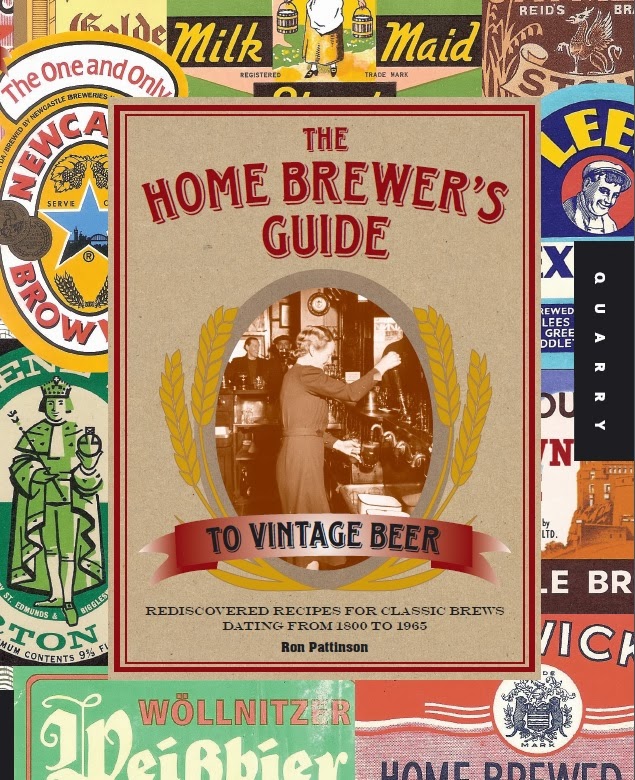
In addition to the recipes, it covers brewing techniques, ingredients and the history and development of each style.
Subscribing to this thread, so that I can get this book on payday. It's absolutely right up my alley....

Last edited by a moderator:
I wonder if it's on Amazon Kindle? I'd like to add it to my collection? I've got the English gruit ale version of the old German Mumme finishing up fermentation atm. Can't wait to bottle it up for a bit of aging! It was said to be sweet, dark & strong as six horses, coach & all...a strong ale resembling a barleywine.
Baja_Brewer
Well-Known Member
If you click the link, you will see that it is, indeed on Kindle...
TasunkaWitko
Well-Known Member
Apologies for the blatant tarting about to take place. My book about home brewing historic beers is published today.
http://www.amazon.com/dp/1592538827/?tag=skimlinks_replacement-20

In addition to the recipes, it covers brewing techniques, ingredients and the history and development of each style.
I recently purchased this book and am about halfway through it. So far, I am loving it and have learned quite a bit.
I am just about to enter a stage where I am going to try to brew some "traditional" beers, and many of those styles are to be found in this book.
My thanks to you for taking the time and doing the research to produce such an interesting and useful resource.
Ron F.
Chinook, Montana
Last edited by a moderator:
My pleasure. I should be self-publishing a new recipe book this week. Effectively an addon pack for the first book.I recently purchased this book and am about halfway through it. So far, I am loving it and have learned quite a bit.
I am just about to enter a stage where I am going to try to brew some "traditional" beers, and many of those styles are to be found in this book.
My thanks to you for taking the time and doing the research to produce such an interesting and useful resource.
Ron F.
Chinook, Montana
TasunkaWitko
Well-Known Member
Thank you, sir -
Please do be sure to let us know how it goes, as well as the details for ordering when the time arrives!
Please do be sure to let us know how it goes, as well as the details for ordering when the time arrives!
TANSTAAFB
Well-Known Member
Looks very interesting, I'll have to check it out. And please let us know when the recipe supplement/ addendum comes out!
10 minutes ago:Looks very interesting, I'll have to check it out. And please let us know when the recipe supplement/ addendum comes out!
http://www.lulu.com/shop/ronald-pattinson/lets-brew/paperback/product-23289812.html
Cover courtesy of my son Alexei:
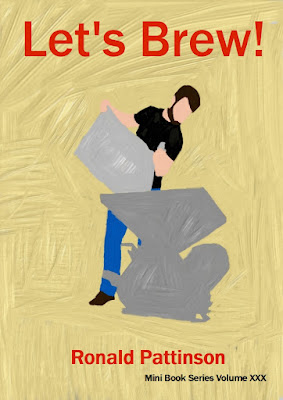
I Mild AleNice! Is there a list of the recipes included?
1914 Adnams XX Mild
1950 Adnams XX Mild
1904 Amsdell XX
1838 Barclay Perkins X Ale
1839 Barclay Perkins XX Ale
1839 Barclay Perkins XXX Ale
1857 Barclay Perkins X Ale
1862 Barclay Perkins XX
1862 Barclay Perkins XXX
1880 Barclay Perkins XX
1880 Barclay Perkins X
1887 Barclay Perkins X
1899 Barclay Perkins X
1914 Barclay Perkins X
1916 Barclay Perkins X
1917 Barclay Perkins X
1917 (April) Barclay Perkins Government Ale
1917 (November) Barclay Perkins Government Ale
1939 Boddington Mild
1955 Flowers XXX
1946 Fullers X
1937 Greene King XX
1950 Lees Best Mild
1958 Lees Best Mild
1963 Lees Mild
1947 Shepherd Neame MB
1916 Tetley X3
1919 Tetley F
1946 Tetley Mild
1956 Shepherd Neame MB
1952 Strong XXX Mild
1969 Truman LM
1917 Wadworth XXXX
1837 Whitbread X
1905 Whitbread XK
1954 Whitbread Best Ale
II Pale Ale
1913 Adnams BLB
1950 Adnams PA
1959 Adnams LBA
1946 Fullers PA
1958 Fullers London Pride
1955 Flowers PX
1955 Flowers GL
1955 Flowers BX
1955 Flowers IPA
1955 Flowers OB
1955 Flowers Stout
1937 Greene King AK
1937 Greene King IPA
1950 Lees Bitter
1984 Maclay PA 6d
1984 Maclay Export
1984 Maclay SPA
1933 Perry IPA
1966 Perry Phoenix Ale
1838 Reid IPA
1947 Shepherd Neame LDA
1947 Shepherd Neame BB
1947 Shepherd Neame BA
1956 Shepherd Neame SXX
1956 Shepherd Neame Abbey Ale
1956 Shepherd Neame PA
1869 Simonds XXX Pale
1952 Strong SAK
1952 Strong Golden Ale
1952 Strong SPA
1885 Thomas Usher 80/-
1855 Truman EI Contract IPA
1877 Truman P1
1883 Truman P2
1883 Truman P1 S
1887 Truman LB
1963 Watneys Keg Red Barrel
1972 Watneys Red
1909 Whitbread IPA
1909 Whitbread PA
1957 Whitbread IPA
1959 Whitbread PA
Whitbread Session IPA
1962 Whitbread Ex PA
1957 Robert Younger Export
1879 William Younger 80/-
III Porter and Stout
1950 Adnams DS Stout
1933 Barclay Perkins Milk Stout
1901 Boddington Stout
1915 Courage Porter
1915 Courage Double Stout
1915 Courage Imperial Stout
1946 Fullers P
1956 Lees Stout
1962 Lees Archer Stout
1935 Perry Special Stout
1937 Perry XX Stout
1837 Reid DBSt
1837 Reid P
1837 Reid BS
1838 Reid EBSt
1838 Reid KBSt
1845 Reid SS
1877 Reid Rg
1877 Reid Crs
1877 Reid S
1877 Reid SS
1877 Reid SSS
1947 Shepherd Neame SS
1952 Strong Black Bess Stout
1858 Tetley SP
1858 Tetley X2P
1858 Tetley X1P
1868 Tetley X3P
1868 Tetley X1P
1850 Truman Export Keeping
1850 Truman Imperial Stout
1856 Truman Crimea Porter
1943 Whitbread Mackeson Stout
1947 Whitbread Stout
1948 Whitbread Extra Stout
1954 Whitbread Mackeson Stout
1973 Whitbread Mackeson Stout
1868 William Younger DBS
1939 William Younger Btlg DBS
IV Strong Ale
1949 Adnams XXXX
1953 Adnams Tally Ho
1891 Barclay Perkins KK
1891 Barclay Perkins KKK
1909 Barclay Perkins KK
1913 Boddington CC
1939 Boddington CC
1914 Courage XX
1955 Flowers SA
1946 Fullers BO
1958 Fullers Old Burton Extra
1958 Fullers Strong Ale
1951 Lees C Ale
1954 Lees Golden Brew
1992 Maclay Scotch Ale
1952 Strong SSB
1853 Reid KK
1853 Reid KKK
1853 Reid KKKK
1954 Tennants Gold Label
1877 Truman K4
1883 Truman S4 x
1887 Truman S3
1887 Truman S5
1914 Truman S3
V Lager
1866 Munich Bock
1896 Munich Lagerbier
1869 Vienna Märzen
1870 Bohemian Summer Beer
1888 Bohemian Export
1929 Bohemian Lagerbier
1929 Bohemian Schankbier
1929 Bohemian Doppelbier
1879 Kulmbacher Export
1911 Heineken Bok
1911 Heineken Gerste
1911 Heineken Beiersch
1911 Heineken Pils
1911 Heineken Lagerbier
1933 Oranjeboom Pils
1933 Oranjeboom Munchener
1933 Oranjeboom Licht Gerste
1933 Oranjeboom Gerste
1933 Oranjeboom Stout
1933 Oranjeboom Bok
1956 Amstel Gold
1956 Amstel Pils
1956 Amstel Oud Bruin
1927 Barclay Perkins Export
1925 Barclay Perkins Dark Lager
1932 Barclay Perkins Draught Lager
1939 Barclay Perkins Sparkling Beer
1942 Barclay Perkins Export
1942 Barclay Perkins Draught Lager
1941 Barclay Perkins Dark Lager
1953 Barclay Perkins Export
1953 Barclay Perkins Sparkling Beer
1953 Barclay Perkins Dark Lager
1953 Barclay Perkins Draught Lager
1959 Lees Lager
1964 Eldridge Pope Konig Lager
1888 Tennent's Lager Beer
1940 Whitbread Lager
1969 Truman LL
VI Brown Ale
1955 Fullers Old Harry
1963 Manns Brown Ale
1956 Shepherd Neame DB
1959 Watneys Brown Ale
1954 Whitbread Double Brown
1954 Whitbread Forest Brown
1968 Whitbread Forest Brown
VII North America
1833 Vassar Double Ale
1833 Vassar Single Ale
1834 Vassar Pale Double Stock Ale
1893 Labbatt Pale Ale
1893 Labatt IPA
1893 Labatt Brown Stout
1904 Amsdell Burton
1905 Amsdell India Pale Ale
1900 Amsdell Winter Stock
1900 Amsdell Winter XX
1900 Amsdell Export Scotch
1900 Amsdell Special Still
1900 Amsdell Light XXX Stock Ale
1901 Amsdell Polar
1901 Amsdell XX
1901 Amsdell Diamond Stock
1901 Amsdell Sth Porter
1904 Amsdell XX
TANSTAAFB
Well-Known Member
Holy sh!tsnacks!
So far I have: The Homebrewers Guide to Vintage Beer - 1909 Style Guide - Scotland! - Porter! - Mild! and the new Let's Brew!
I used Mild! to formulate my own Victorian era style guidelines in Beersmith. I''m working on the same with the 1909 Style Guide to build a Beersmith Edwardian era guidelines.
I used Mild! to formulate my own Victorian era style guidelines in Beersmith. I''m working on the same with the 1909 Style Guide to build a Beersmith Edwardian era guidelines.
That will save me the trouble. I have added a few Victorian styles to BeerSmith, but by no means the full set.So far I have: The Homebrewers Guide to Vintage Beer - 1909 Style Guide - Scotland! - Porter! - Mild! and the new Let's Brew!
I used Mild! to formulate my own Victorian era style guidelines in Beersmith. I''m working on the same with the 1909 Style Guide to build a Beersmith Edwardian era guidelines.
Similar threads
- Replies
- 18
- Views
- 2K
- Replies
- 2
- Views
- 363











































